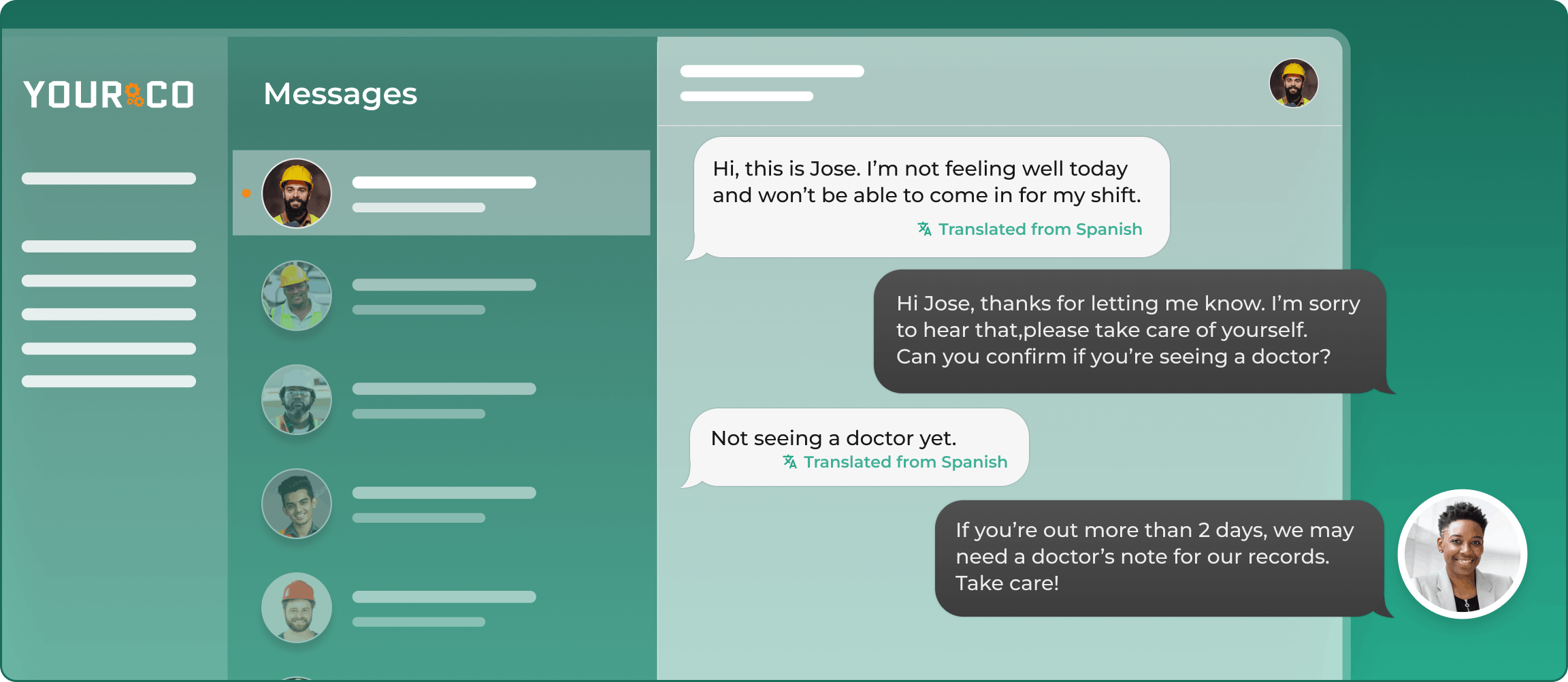How To Take Action on Employee Survey Results


You've done the hard work of running an employee survey, but if nothing happens next, engagement quickly drops. This comprehensive guide closes that gap by walking you through a proven nine-step process that transforms raw feedback into visible workplace improvements. You'll discover how to move from data to action across every environment, with special focus on reaching crews and shifts without desks. First, let's establish what good survey results look like.
Understanding Your Employee Survey Results: What to Expect
Before diving into action steps, it helps to know what good survey results look like and what response patterns signal you're on the right track. If you're still working on gathering effective feedback from your frontline teams, start by reviewing your survey design and distribution methods. This guide focuses on what to do once responses start coming in.
Response rates typically range from 30% to 60% across most organizations. Highly engaged companies often see participation climb above 70%. While high response rates signal strong trust and communication, the quality of responses matters just as much as the quantity. Even a 40% response rate can provide actionable insights if employees share thoughtful, specific feedback rather than rushing through questions.
The feedback you receive will vary by role and environment. A factory worker might express satisfaction with team collaboration while requesting more on-the-job training. Construction crews often ask for more frequent updates from management. Warehouse night shifts may flag equipment issues that day crews never experience. These specific, role-based insights point you toward targeted improvements that genuinely matter to your teams.
Quality feedback shares common traits: it's specific rather than vague, it connects to daily work realities, and it suggests practical improvements. When employees mention concrete examples like "schedules posted too late" or "safety gear often missing," you've gathered feedback you can actually use.
Step 1: Thank Employees and Set Clear Expectations
Send a quick thank-you after your survey closes. Employees need to know their voices matter, and waiting too long makes them wonder if you're going to do anything with their feedback. Use the same communication method you used to distribute the survey. If you sent surveys via text, send the thank-you via text. For guidance on choosing the right communication channels for your workforce, see our article on survey distribution methods.
Text messages work great for this kind of follow-up. SMS reaches non-desk teams where they work and gets read 98% of the time compared to just 20% for email. Keep your message short and clear. If your workforce speaks multiple languages, send the message in each one. Nobody should feel left out of the conversation.
Your thank-you message should cover four things:
- Say thanks
- Tell them when you'll review the results
- Let them know when to expect updates
- Give them a way to ask questions.
Here's a template you can adjust and use:
"Hi team, thank you for taking our survey. We're reviewing your feedback now and will share the top themes in one week, along with the first actions we'll take. Questions? Reply 'ASK' and we'll get back to you. Thanks for helping us build a better workplace!"
Sending this message quickly and in every language your team speaks sets the right tone for everything that comes next.
Pro Tip: Send your thank-you within 24-48 hours to maintain momentum and show respect for employees' time. Waiting more than a week can make employees wonder if their feedback is a priority.
Step 2: Clean and Segment Your Data
Tidy data and smart segments turn survey responses into a clear action plan you can use.
Start by scrubbing your file for duplicate records, blank rows, and obvious outliers. Drop responses that are less than halfway complete, and check that anonymity thresholds (usually five or more responses per group) are met before sharing anything. If you collected open-text comments, run a simple keyword search or AI clustering tool to group similar ideas. Waiting weeks to hand-code every sentence creates unnecessary bottlenecks that delay action.
Next, slice the data in ways that map to real decisions:
- Location
- Shift
- Role
- Tenure
- Language
For example, night-shift warehouse workers may rate "equipment readiness" low while day crews do not, pointing you to a focused fix. Small teams can get what they need with spreadsheet pivot tables. Larger organizations may prefer BI dashboards that display heat-maps by segment.
Keep frontline realities in mind: combine tiny crews so no one gets identified, tag responses by shift code instead of email domain, and never ignore minority language groups. Over-segmenting into cells of one or two people destroys trust just as quickly as lumping everyone together.
Understanding the context behind the numbers matters as much as the scores themselves. If 80% of employees mention communication issues, dig deeper. Are messages not reaching teams in the field? Do certain shifts feel out of the loop? The "why" behind the feedback guides you toward solutions that actually work rather than surface-level fixes that miss the mark.
Pro tip: Yourco’s Frontline Intelligence quickly highlights themes, repeated concerns, and site-level trends so you don’t have to hunt through every comment. It turns raw feedback into clear signals you can act on, helping you spot issues faster and understand what your workforce is really saying.
Step 3: Identify Themes and Root Causes
Move fast from raw data to clear storylines. Start by exporting scores and open-text responses, then group them into common themes. A simple coding sheet, or an AI text-analysis tool, lets you tag comments and count how often issues like "schedule clarity" or "equipment problems" come up. Visual heatmaps of these tags show you which problems matter most.
Once themes emerge, dig into causes before you jump to solutions. The 5 Whys technique works well: pick a pain point, ask "why?" five times, and write each answer until you find a root problem you can fix. Often it's a process gap or resource constraint rather than a vague culture issue.
Now decide where to focus. Rank themes by impact (connection to turnover, safety, or output), effort required, and how much control managers have over them. Organizations that focus energy on one to three high-impact issues avoid survey fatigue and build credibility.
Separate local problems from company-wide issues. If one site's night shift scores low on "tools available" while every location struggles with "pay transparency," you've found a local quick win and a systemic priority. For frontline teams, break down data by shift and supervisor so voices without email access are still heard and addressed.
Keep in Mind: Set a deadline for completing your analysis and moving to action planning. Two weeks is usually enough time to identify clear themes and start developing responses. Spending months analyzing data without taking action undermines the entire survey process.
Step 4: Run Targeted Follow-Up Surveys
Send your first follow-up questions within two weeks of closing your initial survey to keep responses fresh and relevant. This timing captures early impressions while themes from the first survey are still clear in employees' minds. The goal isn't another comprehensive survey, but to dig deeper into specific areas where you need clarity.
Transform vague ratings into actionable insights with targeted questions. If your initial survey showed low scores for "manager support," don't just ask for another rating. Instead, try:
- "What could your manager do differently to support you better?"
- "Can you share a recent example where you felt unsupported, and what would have helped?"
Frame questions around improvement, not blame. Use curious, non-judgmental language that encourages honest responses. Start with broader questions, then follow up with specifics:
- "How manageable is your workload lately?"
- "What changes could improve your work-life balance?"
This approach builds psychological safety and gets you stories behind the numbers.
Match your follow-up method to how your teams work. Anonymous SMS survey works best for non-desk staff who need to respond on the go and may hesitate to criticize managers face-to-face. Schedule these during paid shifts so hourly workers can respond without extending their workday.
Step 5: Translate Insights Into Measurable Goals
The fastest way to turn feedback into real change is simple: convert each priority theme into a clear, trackable goal. The SMART (Specific, Measurable, Achievable, Relevant, Time-bound) framework works best here.
Start by writing the goal in everyday language, then add the five SMART elements. If frontline crews say they "never find the right protective gear," your goal might read: "By day 60, 95% of employees will confirm PPE is stocked at the start of every shift, measured through a two-question SMS pulse." Next, assign an owner (ideally the maintenance lead on that shift) and list what support they need.
Keep everything organized on a simple one-page grid:
- Action
- Success Metric
- Owner
- Start Date
- Deadline
Try the 30-60-90 Action Planning Model
Many organizations find the 30-60-90 day action planning model helpful for organizing initiatives. This framework breaks your response into three phases: quick wins you can accomplish in the first 30 days, medium-term improvements you'll complete by day 60, and longer-term changes that require a full quarter to implement. This phased approach lets you show progress early while tackling more complex challenges.
Create Templates for Post-Survey Communications
Create a clear employee survey results template that connects feedback to action. This summary should follow a simple format:
What You Said: [Theme from survey feedback]
What We Heard: [Your interpretation of the concern]
What We're Doing: [Specific action you'll take]
Timeline: [30/60/90 day milestone]
Who's Responsible: [Name and role of owner]
This structure makes your action plan transparent and easy to follow, showing employees exactly how their feedback shapes real changes.
Step 6: Assign Owners and Build Small Working Groups
Give every action a name and a face. Without clear ownership, momentum stalls and trust erodes. Assign one person as the go-to owner for each initiative. This person takes full accountability for the result, rallies support, tracks progress, and reports back. When no one owns the outcome, follow-through collapses and future participation drops.
Build a small cross-functional team around each owner. Keep it to three to five people drawn from HR, operations, and the frontline shift most affected. This keeps teams nimble while ensuring you have the right expertise and perspectives. Include frontline voices so your actions stay practical and grounded in daily realities. Avoid making teams too large or giving multiple people joint ownership without clear responsibilities. These approaches lead to finger-pointing and stalled progress.
Set clear expectations during your kick-off meeting. Define weekly time commitments, clarify who makes which decisions, and establish a 30-day check-in schedule. This structured approach prevents confusion later.
Pro Tip: Name one person as the primary owner, with others serving as supporting team members with specific tasks. Clear, single-point ownership prevents confusion and ensures accountability when deadlines approach.
Step 7: Communicate Results and Next Steps to Everyone
Share what you heard and what will change, then keep the conversation going. Clear, consistent messaging across every shift and worksite builds trust and gets people moving.
Why Transparency Matters
Research shows that when workers feel heard, they're about five times more likely to put their best foot forward at work. Sharing results isn't just good practice; it's what drives continued engagement and makes employees more likely to participate in future surveys.
How to Present Survey Findings
Use the same distribution channels you used for the survey itself. If you distributed via SMS, share results via SMS. If you used email for office staff and SMS for frontline workers, maintain that same approach. For detailed guidance on choosing and using distribution channels effectively, see our complete guide on survey distribution platforms.
Thank employees again for their participation and reiterate why their input matters. Focus on what's in it for them: how their feedback will improve their specific job roles or relationship with the company. Present the key insights revealed by the survey responses. Many employees naturally wonder how their coworkers responded, so share how the whole workforce felt about different topics.
Make Communication Inclusive
Language matters. Translate each message using AI-powered tools or a committee-based process so every worker reads a version that feels natural. Pair plain text with visuals (charts, photos, or short videos with captions) to help workers with different literacy levels or limited data plans.
Remote or distributed teams can join five-minute video recaps posted on the intranet and pushed by SMS links. Reinforce key points weekly: one fact, one action, one milestone. Staying consistent shows progress, prevents rumors, and keeps momentum strong for your next steps.
Step 8: Implement Longer-Term Initiatives With Clear Milestones
Big changes take time, so create a roadmap everyone can follow. Turn each initiative into a simple milestone chart that shows key checkpoints, who's responsible, and when things are due. A one-page timeline keeps teams aligned when competing priorities demand attention.
Start small before rolling out company-wide. Launch a pilot at one site or shift first. This focused test reveals hidden problems like system conflicts, communication gaps, or training needs without disrupting your entire operation. Pair each pilot with clear success metrics so you can quickly decide whether to expand, adjust, or abandon the approach.
Make progress visible to fuel momentum. Have senior leaders review milestones and publicly recognize teams that hit their targets. A quick shout-out during shift changes or in team updates shows the work matters. Weekly check-ins with task owners and monthly progress reviews prevent plans from gathering dust.
Watch for common problems early: unclear deadlines, tasks without owners, or resources getting pulled away. When these issues surface, adjust timelines or reassign responsibilities immediately rather than waiting for the next assessment. Quick course corrections separate successful follow-through from good intentions that stall out.
Step 9: Track Progress and Adjust Regularly
Build progress tracking into your weekly routine, or even the best action plan will disappear. Set up 20-minute check-ins every week so each named owner stays on track with their tasks. Then create a simple one-page update each month for leadership. This regular rhythm turns insights into lasting change.
Track What Matters
Response rates look good on paper, but they mean nothing if equipment is still missing or shift swaps still take days to approve. Focus on things you can control, like how fast PPE gets restocked or how early schedules get posted. Then measure the results that count, such as turnover rates, safety incidents, and attendance. A simple dashboard or printed chart keeps these numbers where everyone can see them.
When Something Isn't Working, Fix It Fast
Add the problem to your weekly meeting, dig into what's really causing it, and move resources before you lose momentum. Regular, honest reviews keep your action plan alive and working.
Once you've made visible progress, start planning the next cycle. Confirm budget, assign owners, and set a realistic timeline that leaves room to finish current goals without overwhelming people. Use brief pulse checks every 60–90 days to track ongoing progress between full surveys. Continuous improvement works best when employees can see the loop in action, from their feedback to the fixes, and into the next set of priorities.
Schedule a Follow-Up Survey
Follow-up surveys help you measure whether your initiatives moved the needle. When you run the same survey six months or a year later, compare the new results to your baseline. Share these comparisons with employees to show them that their previous feedback created measurable change. This visible progress encourages future participation and demonstrates that the survey process delivers real results, not just empty promises.
Pro Tip: Protect your weekly check-in time on your calendar and treat it with the same importance as any other business-critical meeting. Consistent tracking separates successful action plans from good intentions that quietly fade away.
Three Ways Survey Follow-Through Falls Apart
Even well-intentioned managers can undermine survey credibility if they fall into these common traps:
Go silent. Employees submit thoughtful feedback, then hear nothing back. No acknowledgment, no results shared, no updates on what's changing. This silence sends a clear message: their opinions don't matter. Trust takes years to build and moments to destroy. When workers never find out what happened with their survey responses, they stop participating in future feedback requests.
All talk, no action. You share the results and discuss the findings, maybe even create an impressive action plan document. But weeks pass and nothing actually changes. Schedules still get posted late. Equipment still goes missing. Communication still feels one-sided. Employees quickly learn to ignore future surveys because they know the pattern: lots of discussion, zero follow-through.
One and done. You implement some changes, but never follow up to show progress or ask for feedback on whether the improvements actually helped. There's no next survey to compare results. No pulse checks to track whether issues are resolved. The feedback loop breaks, and employees wonder if their input ever mattered or if the survey was just checking a box for HR.
When follow-through breaks down at any of these points, future survey response rates drop and the quality of feedback declines. Workers who believe their input leads nowhere provide shorter, less thoughtful responses or skip surveys entirely. Rebuilding that trust takes consistent action over multiple survey cycles.
Close the Feedback Loop With Better Communication
Following up on survey feedback creates a steady pattern of listening, making changes, and keeping everyone updated. The nine steps detailed above give you a clear roadmap: thank employees quickly, dig into the data, find the real problems, set specific goals, and track what's working. When you stick to this process, you keep the momentum going and set realistic expectations.
When you skip the follow-through, employees' trust drops, and fewer people bother responding to future assessments. But when they see quick updates (especially those early wins), engagement scores climb and business results improve.
Yourco helps you close that feedback loop faster. You can send multilingual SMS updates that reach team members instantly, and get read by 98% of recipients compared to just 20% for emails. Built-in segmentation means you can target specific shifts or locations, while two-way texting lets you gather quick feedback without requiring apps or complex logins. The dashboard tracks your action items so you always know what's on schedule and what needs attention.
Ready to turn feedback into real workplace improvements? Try Yourco for free today or schedule a demo to see how quickly you can move from collecting responses to making meaningful changes that your team will notice.
Frequently Asked Questions
How soon should we share survey results with employees?
Acknowledge the assessment within 24-48 hours, then share a clear "you said, we're doing" summary within two to four weeks after the survey closes. Quick thanks keep people engaged, and timely updates build trust and encourage participation in future feedback rounds.
How often should we repeat the full survey vs. pulse checks?
Run a comprehensive assessment once a year and send brief, targeted pulse checks every 60 days. This gives you enough time to act on feedback while staying connected to how things are progressing with your team. This rhythm works well for most organizations.
Should I share survey results even when feedback reveals problems?
Yes, always share results with employees, including negative feedback. Transparency builds trust and shows your team that you're willing to listen honestly. When employees see you acknowledge challenges and commit to addressing them, they feel valued and stay more engaged. Sharing results also encourages future participation because employees see their input creates real change rather than disappearing into a void.
Research shows that negative scores mean it's time to act, not panic. Share the findings honestly with your team, dig into what's really causing the problems, and focus on fixing one to three major issues first. Taking visible action on problems employees care about helps restore trust and improves response rates next time.
How should I structure surveys for shift workers and field employees?
Keep surveys brief and use mostly multiple-choice questions with just one open-ended question at the end. Frontline workers face tight schedules and may respond during breaks or between tasks, so lengthy text responses reduce completion rates. This streamlined approach respects their time while still capturing meaningful insights. Always send surveys during paid work hours so hourly employees can participate without working off the clock.
What if our survey response rate is low?
Low response rates often signal communication, transparency, or accessibility issues rather than employee apathy. For non-desk workers especially, email-based surveys rarely work. Consider switching to SMS distribution, which reaches 98% of recipients and requires no apps, passwords, or internet access. Also communicate clearly before launching the survey about its purpose and how results will be used. When employees trust that their feedback will lead to real changes, participation increases significantly.






